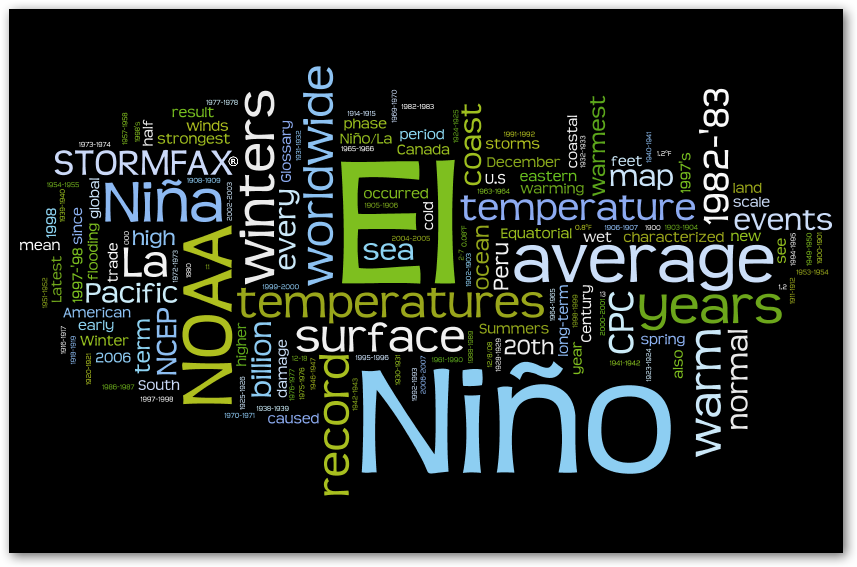



 EL NIÑO
EL NIÑO

ANOMALOUS: Irregular or inconsistent.
ATMOSPHERIC PRESSURE: The force exerted by the weight of air above a given point, usually expressed in millibars (mb) or inches of mercury (in. Hg).
BAROMETER: Instrument for measuring atmospheric pressure.
Bjerknes, Jacob: The University of California professor who, in 1969, recognized that the warm waters of El Niño and the pressure variations of Southern Oscillation are part of the same phenomenon (ENSO).
CHLOROPHYLL: The green plant substance produced by phytoplankton, forming the nutrient base of the ocean ecosystem.
COASTAL UPWELLING: Strong, wind-driven currents along the coasts of California and Peru are deflected westward, away from the coast, by the Coriolis Force resulting from the Earth's rotation. The water that rises to the surface to as the surface water moves away from the coast is "upwelled." Upwelled water is cold, but rich in nutrients.
COASTAL ZONE COLOR SCANNER: An optical instrument carried on board a satellite that measures green in the surface water of the ocean, providing an indication of chlorophyll content.
CORIOLIS FORCE: The effect of the Earth's rotation which deflects the pole-to-Equator motion of any object or fluid toward the right in the Northern Hemisphere and to the left in the Southern Hemisphere.
EASTERLIES: East-to-west surface winds that extend nearly all the way across the equatorial Pacific.
ECOSYSTEM: A community of organisms and their environment.
EL NIÑO: Spanish for "the boy." Fishermen in Peru and Ecuador used the term to refer to a periodic warming of Pacific Ocean waters (warm event) at Christmas.
ENSO: The acronym for El Niño and Southern Oscillation to describe the linkage between the two phenomena.
EQUATORIAL UPWELLING: A band of rising water along the Equator that replaces westward-flowing surface water deflected away from the Equator by the Coriolis Force. The westward flow is driven by the trade winds.
HIGH-INDEX PHASE: The phase of the Southern Oscillation characterized by higher-than-normal pressure on the eastern side of the Pacific and lower-than-normal pressure on the western side. The stronger-than-normal pressure difference across the equatorial Pacific during the high-index phase produces stronger-than-normal easterly trade winds.
INFRARED SATELLITE IMAGERY: Radiometers carried by satellites in space monitor the infrared radiation emitted from the warm Earth. These measurements are used to produce infrared images which show the distribution of sea-surface temperature and clouds.
JET STREAM: A global belt of strong westerly winds in the atmosphere. The jet stream forms the dividing line between warm, tropical air masses and cold, polar air masses. The jet stream steers weather systems around the Earth.
LA NIÑA: Spanish for "the girl." A term used to refer to the periodic cooling of Pacific Ocean waters (cold event). This phenomenon has been called El Viejo, meaning "the old man" (the opposite of El Niño).
LOW-INDEX PHASE: The phase of the Southern Oscillation characterized by an abnormal weakening of the sea-level pressure contrast across the equatorial Pacific, accompanied by a weakening of the easterly trade winds.
MONSOON: The rainy season over the tropical continents that normally occurs during the Summer, when the continents tend to be warmer than the nearby oceans.
PHYTOPLANKTON: Tiny plant species that float freely in the water.
PROXY EVIDENCE: Data obtained through historical records, such as core samples and tree rings.
SOUTHERN OSCILLATION: The periodic strengthening and weakening of the contrast in sea-level barometric pressure between the eastern and western sides of the Pacific. Normally, the pressure is higher on the eastern side, driving the easterly trade winds in the equatorial belt. The Southern Oscillation causes the pressure contrast and the strength of the easterlies to fluctuate between high-index (strong trade winds) and low-index (weak trade winds) conditions.
SST: Sea surface temperatures.
THERMOCLINE: Layer of ocean water that divides the mixed layer (a layer of relatively warm water just below the surface) from colder, deeper water.
UPWELLING: Term used to describe the process by which cold, nutrient rich water rises up to the surface to replace water that has been moved away horizontally. The world's major fisheries coincide with regions of upwelling.
Walker, Sir Gilbert: The British scientist who, in 1923, recognized the relationship between barometric readings at stations on the eastern and western sides of the tropical and southern Pacific. (Southern Oscillation).
WESTERLIES: West-to-east winds occurring in the mid-latitudes in both hemispheres.

 Please read our Legal Notice and our Privacy Statement.
Please read our Legal Notice and our Privacy Statement.
